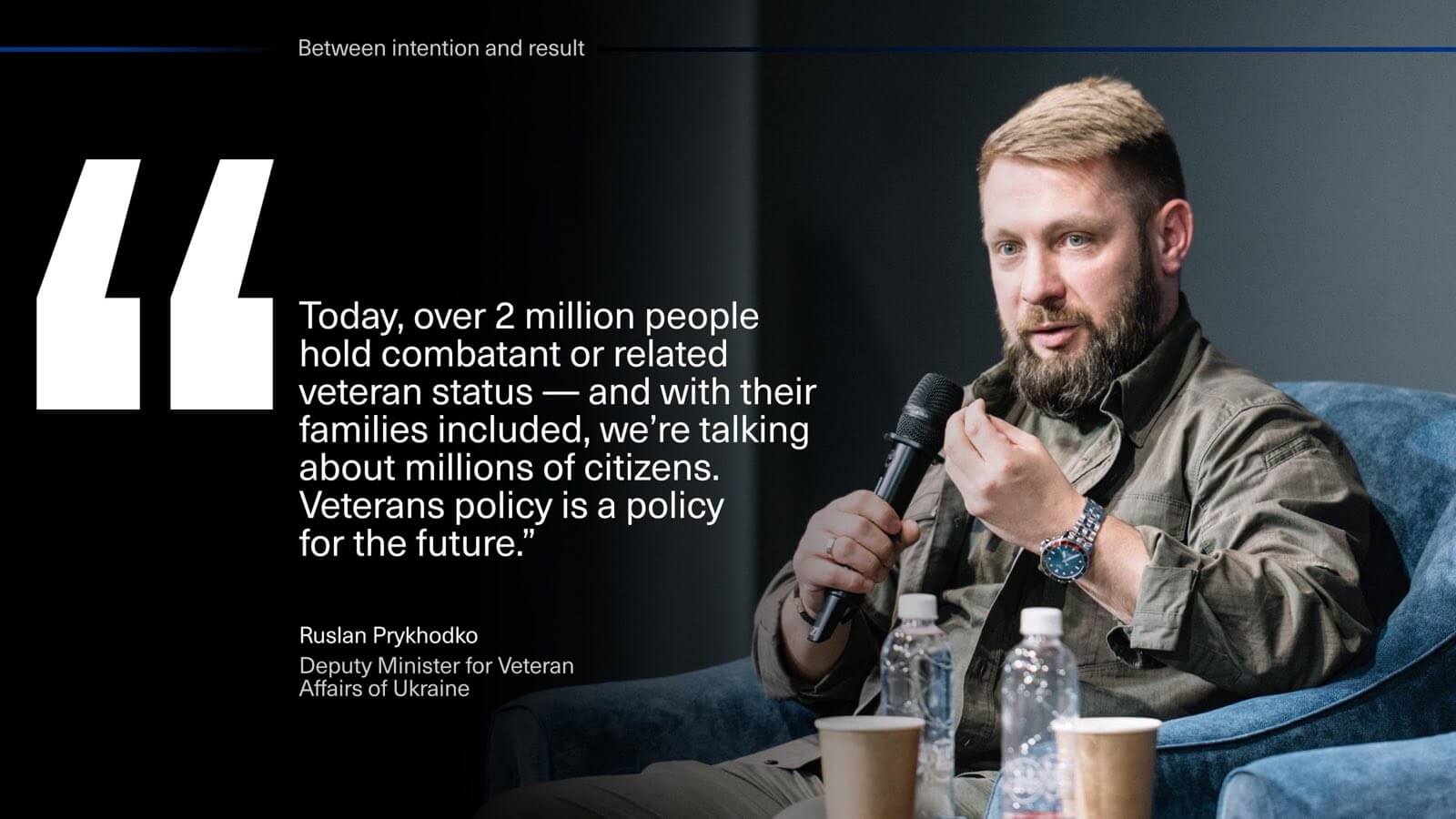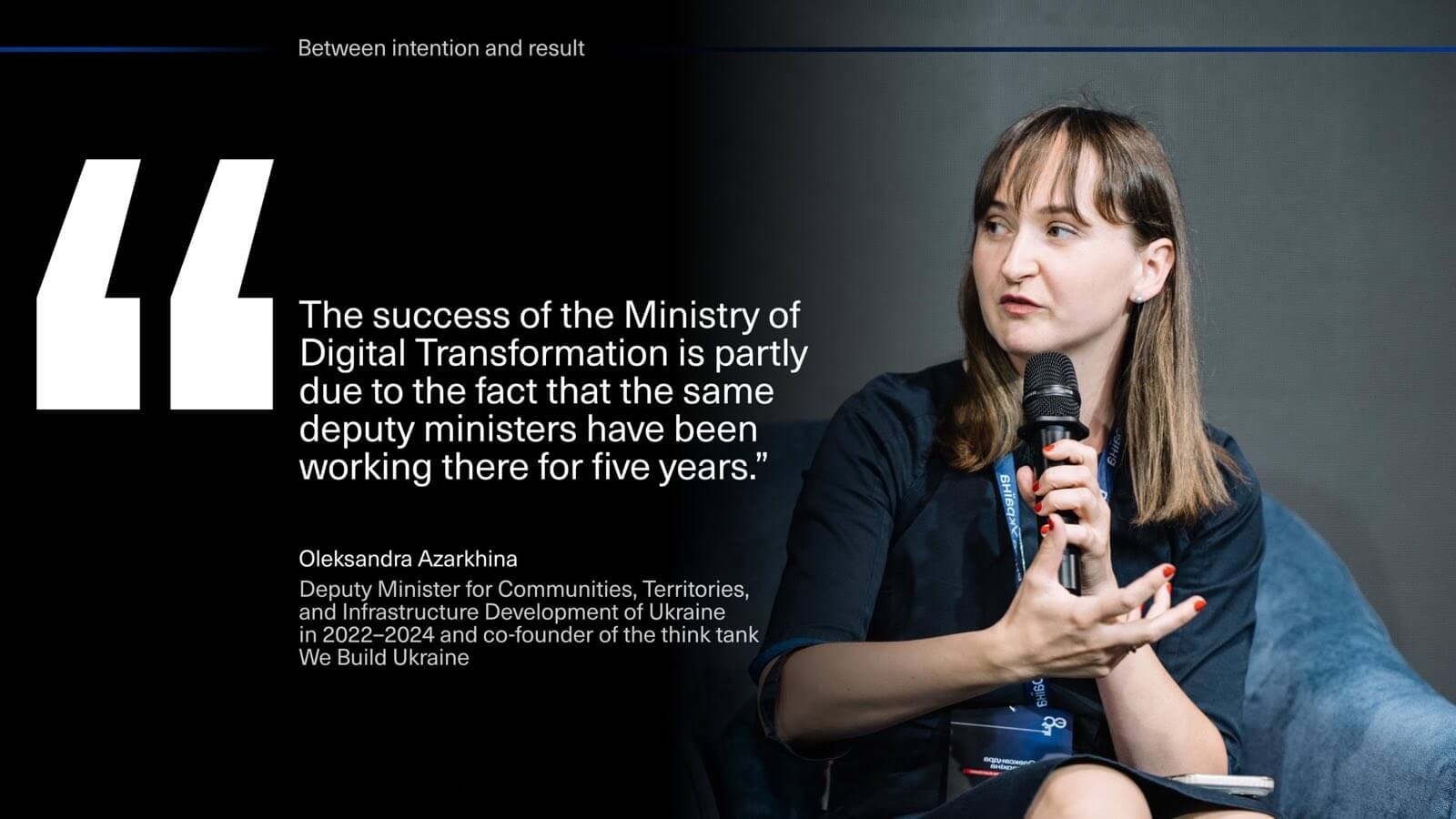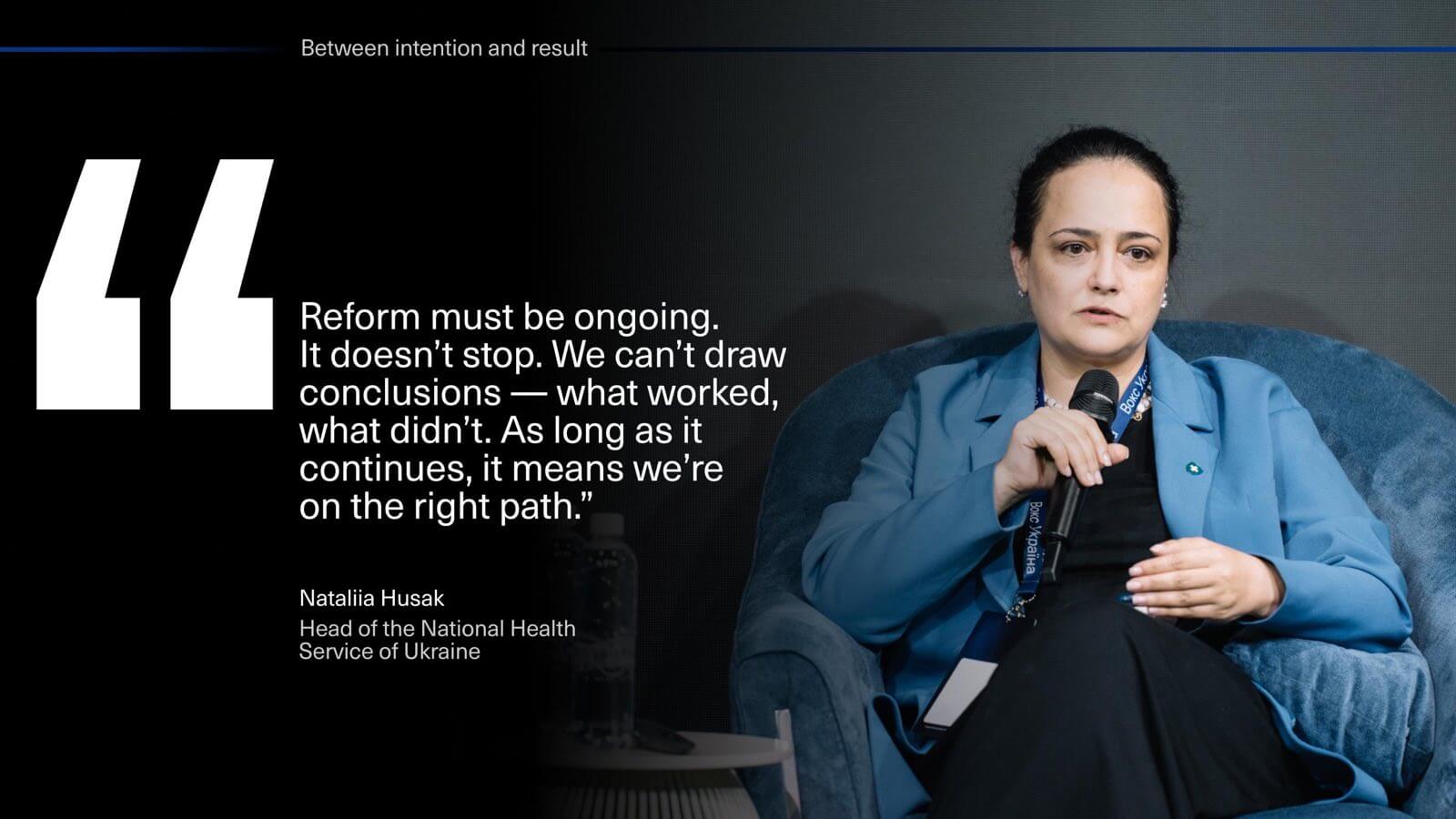On May 23, 2025, Vox Ukraine held a conference titled “EU. But There Is One Twist,” dedicated to discussing Ukraine’s progress in European integration, reforms in Ukraine, and the transformation of Europe. One of the conference’s key events was the panel discussion “From Intention to Outcome,” which focused on the challenges and opportunities of reforming the state in the midst of war. Experts from various government sectors, including healthcare, digital transformation, veterans’ affairs, and infrastructure reconstruction, joined the conversation. The panel was moderated by Ukrinform journalist Svitlana Tkachuk.
Panel participants included:
- Ruslan Prykhodko – Deputy Minister for Veteran Affairs of Ukraine
- Nataliia Husak – Head of the National Health Service of Ukraine
- Kateryna Chernohorenko – Deputy Minister of Defense for Digitalization
- Oleksandra Azarkhina – Deputy Minister for Communities, Territories, and Infrastructure Development of Ukraine in 2022–2024 and co-founder of the think tank We Build Ukraine
The speakers shared their experiences in implementation of reforms that seemed straightforward on paper but proved far more complex in practice. The discussion centered on issues of accountability, administrative capacity, digital solutions, and the evolving role of citizens in driving change.
Special thanks to Kateryna Hres and Yana Balanchuk, analysts at VoxCheck, for preparing this article based on the speakers’ remarks.
The event was organized by Vox Ukraine with support from the National Endowment for Democracy (NED) on May 23, 2025. A recording of the conference is available at the link.
Veterans Policy: From Benefits to Community Leadership
Ruslan Prykhodko emphasized that Ukraine is one of the few countries shaping veterans policy amid active combat. The state is working to move away from the old Soviet model of social protection — which centered on a standard package of benefits like free transportation, priority service, and cash assistance — toward a modern approach focused on veterans’ development and integration. What matters most, he noted, is understanding what follows after military service — how people adapt and find purpose in civilian life.
“Today, over 2 million people hold combatant or related veteran status — and with their families included, we’re talking about millions of citizens. Veterans policy is a policy for the future,” Prykhodko said. According to him, the goal is to create the conditions for veterans to become leaders in their communities, support their mental and physical recovery, and help them become agents of change. But this shift requires more than just new institutions — it demands a break from paternalistic expectations in parts of society that the state should provide for every need of its citizens. Instead, the reform aims to build tools which individuals can use independently — “amplifying opportunities in the shift from dependence to empowerment”.

It is also crucial to avoid overlapping responsibilities between the central government and regional authorities. Prykhodko pointed out that local governments often create programs similar to those already run by the Ministry of Health or the Ministry for Veterans Affairs. The result is inefficient spending and, at the same time, numerous gaps and unmet needs. Currently, efforts are underway to integrate veterans policy into a unified system — with clear KPIs, regional structures, and digital services like the veterans’ section of the Diia app.
Healthcare Reform: Staying Grounded in Reality
Nataliia Husak spoke about the challenges of reforming Ukraine’s healthcare system. During the course of reform implementation, the system has faced two major crises: the COVID-19 pandemic and the full-scale invasion. Yet, in both cases, the reform was not halted — on the contrary, the planned changes continued to move forward.
According to Husak, the biggest challenges stem not only from the technical complexity of the reforms but also from the societal strain. People are exhausted and do not always trust the state — especially when it comes to sensitive issues like healthcare. Therefore, it is important to avoid creating unrealistic expectations, which can deepen disappointment. “What matters most is not whether expectations match reality — it’s the progress itself,” she noted.
Nataliia emphasized that digital tools, like the electronic patient portal, require years of preparation. She also stressed the importance of trust in successfully implementing reforms. At every stage, it is essential to bring in people who truly understand the reform’s purpose and resist the temptation to oversell it as something quick or easy. She added that healthcare reform must continue through the development of effective control mechanisms, such as data verification and expense monitoring, to ensure that funds actually reach patients in the form of high-quality, free services.
European integration represents a third major challenge for the healthcare system. Despite the difficulties, Ukraine is steadily moving toward a European model that is people-centered and built on digital solutions.

The Digital State: Speed as a Strategy
Kateryna Chernohorenko, Deputy Minister of Defense for Digital Development, emphasized that digitalization is not just about launching new services — it is about transforming the very logic of public governance. It means shifting toward a culture where the focus is not on the system itself but on an individual interacting with it. In the case of the Ministry of Defense, this individual is the military service member.
This approach is embodied in digital platforms like Reserve+ and Army+, which fundamentally changed how service members communicate with the Ministry of Defense. The priority is convenience for the individual — not the institution. For example, in the past, submitting a report to request a transfer or return to service involved navigating multiple layers of in-person approval, often with delays and the risk of lost paperwork. Now, the process can be initiated independently: the request is submitted online, immediately registered in the system, and routed to the appropriate unit. A decision is made within 24 hours. Because the report creates a digital trace, it compels those responsible to respond.
Another example is the new approach to deferments. Previously, these decisions were made manually, heavily dependent on the discretion of individual officials, which led to delays and potential bias. Now, the system automatically verifies data from national registries — such as whether a person is caring for someone with a disability, how many children they have, or if they work in a critical sector. Decisions are made without human involvement, based on clear criteria, reducing the risk of abuse.
Kateryna Chernohorenko shared other examples of how digital tools are reshaping the logic of state functioning. One is the Transfer Report for military personnel. Previously, transferring between units was nearly impossible, which led to demotivation and non-combat losses. The Ministry of Defense team introduced a digital procedure that has already facilitated the transfer of over 30,000 service members. Another tool — Return Report — has already enabled two thousand AWOL soldiers to return to service.
She noted that every decision in the system leaves a digital footprint, making it possible to track and appeal outcomes. This builds a new culture — service-oriented, transparent, and less reliant on human discretion.
Reforms and Long-Term Resolve: Keeping the Goal in Sight
The next focus of the discussion was the sustainability of reforms and the importance of teams capable of driving long-term change. Oleksandra Azarkhina emphasized that one of the biggest mistakes reformers make is planning ambitious changes without ensuring there are people in place to push them forward.
“The success of the Ministry of Digital Transformation is partly due to the fact that the same deputy ministers have been working there for five years,” she said. Azarkhina also stressed that sustainability does not mean rigidity. Sustainability is about institutions. Reforms cannot depend solely on individual leaders; they need to be embedded in processes and designed to continue even as [ministry] staff changes.

One successful example is the DREAM project, which is focused on transparent reconstruction. The initiative continues even after a change in political leadership thanks to a strong legal framework and the conditionalities set by international partners, which help ensure Ukraine stays on course and implements its commitments.
Nataliia Husak joined this part of the conversation to highlight the need to balance short-term results with long-term strategic vision. In her view, quick wins are essential for maintaining public trust — especially in times of crisis. However, reforms cannot rely on short-term achievements alone. Without strategy and foresight, such wins remain isolated and fail to build a sustainable system.
“Reform must be ongoing. It doesn’t stop. We can’t draw conclusions — what worked, what didn’t. As long as it continues, it means we’re on the right path,” Husak emphasized.
Despite working in different sectors, all panelists agreed on several key points: reforms are impossible without trust, continuity in decision-making, and a clear focus on the end user — be that a citizen, a service member, or a patient. The success of reform depends not only on the quality of strategies but also on the ability to keep moving forward despite war, resistance, and fatigue.

Photo by Kateryna Lashchykova
Attention
The authors do not work for, consult to, own shares in or receive funding from any company or organization that would benefit from this article, and have no relevant affiliations




